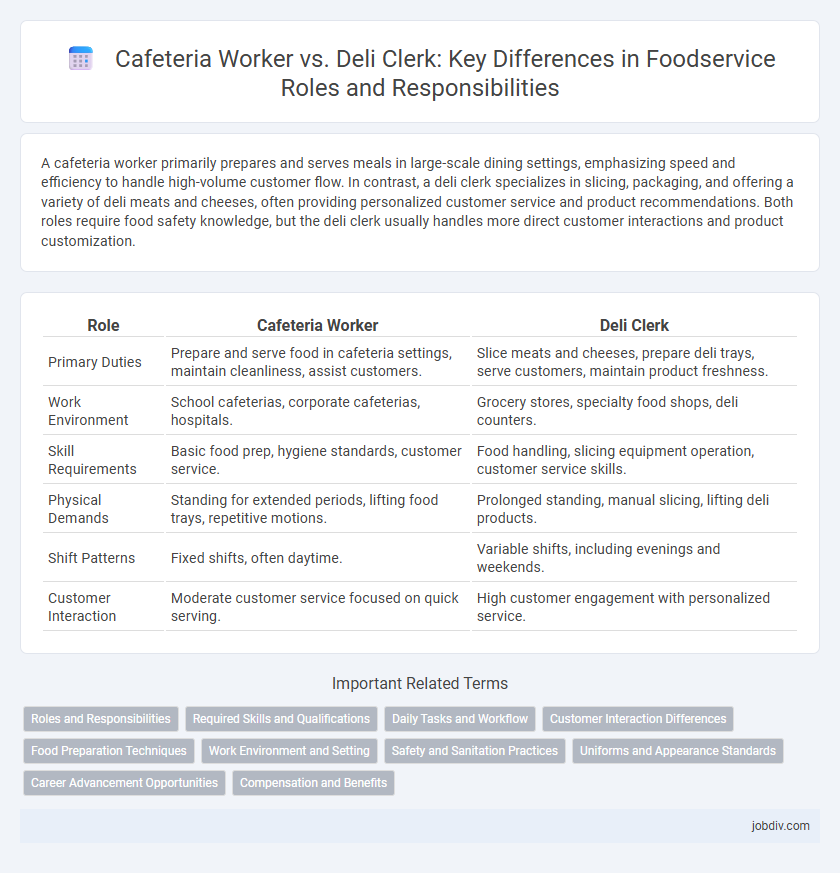A cafeteria worker primarily prepares and serves meals in large-scale dining settings, emphasizing speed and efficiency to handle high-volume customer flow. In contrast, a deli clerk specializes in slicing, packaging, and offering a variety of deli meats and cheeses, often providing personalized customer service and product recommendations. Both roles require food safety knowledge, but the deli clerk usually handles more direct customer interactions and product customization.
Table of Comparison
| Role | Cafeteria Worker | Deli Clerk |
|---|---|---|
| Primary Duties | Prepare and serve food in cafeteria settings, maintain cleanliness, assist customers. | Slice meats and cheeses, prepare deli trays, serve customers, maintain product freshness. |
| Work Environment | School cafeterias, corporate cafeterias, hospitals. | Grocery stores, specialty food shops, deli counters. |
| Skill Requirements | Basic food prep, hygiene standards, customer service. | Food handling, slicing equipment operation, customer service skills. |
| Physical Demands | Standing for extended periods, lifting food trays, repetitive motions. | Prolonged standing, manual slicing, lifting deli products. |
| Shift Patterns | Fixed shifts, often daytime. | Variable shifts, including evenings and weekends. |
| Customer Interaction | Moderate customer service focused on quick serving. | High customer engagement with personalized service. |
Roles and Responsibilities
Cafeteria workers primarily manage food preparation, serving meals, and maintaining cleanliness within a cafeteria setting, ensuring efficient flow during peak hours. Deli clerks specialize in slicing meats and cheeses, assembling sandwiches, and providing personalized customer service in a deli environment. Both roles require strict adherence to food safety regulations but differ in focus, with cafeteria workers overseeing bulk meal service and deli clerks emphasizing customized orders.
Required Skills and Qualifications
Cafeteria workers require proficiency in food preparation, customer service, and adherence to health and safety regulations, often needing basic culinary skills and the ability to operate kitchen equipment. Deli clerks must possess strong product knowledge, slicing and portioning skills, and the ability to handle food with care, along with customer interaction abilities and sometimes cash handling experience. Both roles demand attention to detail, teamwork, and compliance with food safety standards, but deli clerks typically require more specialized knowledge of deli meats and cheeses.
Daily Tasks and Workflow
Cafeteria workers manage food preparation, serving, and maintaining cleanliness in high-traffic dining areas, ensuring efficient meal distribution during peak hours. Deli clerks focus on slicing meats and cheeses, assembling sandwiches, and providing personalized customer service at deli counters. The workflow for cafeteria workers emphasizes batch food handling and rapid service, while deli clerks prioritize precision slicing and customized orders.
Customer Interaction Differences
Cafeteria workers primarily manage fast-paced food service lines, focusing on efficient tray assembly and maintaining smooth customer flow, often requiring quick, courteous communication with numerous patrons. Deli clerks engage more directly with customers, offering personalized service such as meat and cheese slicing, product recommendations, and handling special orders, which fosters a more interactive and consultative customer experience. These distinct roles highlight differing interaction intensities: cafeteria workers provide rapid, transactional exchanges, while deli clerks emphasize individualized attention and customer relationship building.
Food Preparation Techniques
Cafeteria workers specialize in bulk food preparation techniques, including portion control, batch cooking, and maintaining consistent quality across large servings. Deli clerks focus on slicing, dicing, and assembling deli meats and cheeses with precision while adhering to food safety standards for ready-to-eat items. Both roles require knowledge of sanitation protocols and efficient use of kitchen equipment to ensure fresh and safe food service.
Work Environment and Setting
Cafeteria workers typically operate in institutional settings such as schools, hospitals, or corporate dining halls, where fast-paced service and large volume food preparation are common. Deli clerks work in grocery stores, specialty food markets, or delis, focusing on personalized customer service, slicing meats, and preparing sandwiches in a smaller, retail-oriented environment. Both roles demand food safety compliance and customer interaction, but the cafeteria worker's environment is more structured and production-oriented compared to the deli clerk's retail and customer-focused setting.
Safety and Sanitation Practices
Cafeteria workers and deli clerks both adhere to strict safety and sanitation protocols to prevent foodborne illnesses, including regular handwashing, proper glove use, and sanitizing surfaces. Cafeteria workers often handle hot food and must ensure cooked items reach safe internal temperatures, while deli clerks focus on preventing cross-contamination between raw and ready-to-eat meats by using separate cutting boards and utensils. Both roles require compliance with local health department regulations and ongoing training in food safety standards such as ServSafe certification.
Uniforms and Appearance Standards
Cafeteria workers typically wear standardized uniforms such as polo shirts, aprons, and hairnets to ensure hygiene and a professional look, while deli clerks often sport branded shirts or jackets paired with hairnets and gloves to meet food safety regulations. Both roles emphasize clean, wrinkle-free attire and closed-toe, non-slip shoes to maintain safety and sanitation standards. Appearance standards require minimal jewelry and neat hairstyles to prevent contamination in foodservice environments.
Career Advancement Opportunities
Cafeteria workers often advance through roles such as shift supervisor or food service manager, leveraging skills in team coordination and operational efficiency. Deli clerks can progress by specializing in meat and cheese expertise or moving into retail management positions, enhancing inventory and customer service capabilities. Both paths offer distinct career advancement opportunities tailored to their specific foodservice environments and skill sets.
Compensation and Benefits
Cafeteria workers typically earn an average hourly wage of $11 to $15, with benefits including meal discounts and limited health coverage depending on the employer. Deli clerks often receive similar pay ranges but may have access to additional incentives such as commission-based bonuses and extended health benefits in larger retail chains. Both roles commonly offer part-time positions where eligibility for full benefits varies based on hours worked and company policies.
Cafeteria Worker vs Deli Clerk Infographic

 jobdiv.com
jobdiv.com